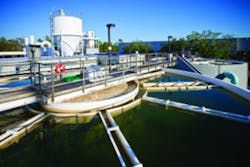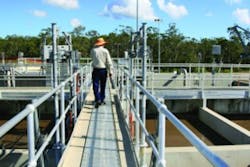Equipment, chemical usage system evaluation helps improve wastewater treatment
The two following case examples illustrate the importance of a sound system evaluation prior to any equipment purchase and how a clear understanding of chemical cost and performance can benefit the bottom line.
Issuing purchase orders is not always the right answer
During a recent overall facility survey, a consulting team gave serious consideration to the "equipment-purchase question." The initial task was to take steps that optimized the wastewater treatment to maintain discharge-permit compliance.
The overriding consideration in these discussions was whether additional wastewater treatment process units, such as secondary treatment, were required to maintain discharge permit compliance.
After establishing the procedures, we started looking at any needs for specific equipment purchases. In particular, purchase of an equalization tank and a sludge dewatering press filtration process unit were considered and rejected for the reasons discussed below.
Decision parameters
To decide whether to purchase an equalization tank, we analyzed the quality of the treated wastewater collected or composited over a 24-hour period in a wastewater composite sampler, which is the discharge-permit requirement.
The analysis showed that over a 24-hour period quality treatment in the composite sampler achieved equalization. No equalization tank had been required in the previous 15 years, and none was needed now.
Turning to the sludge-dewatering equipment, we first looked at what equipment and tanks were already on site. Justification for any purchase would be based on the prospect of a more effective way to remove water from sludge, so that the sludge could be efficiently disposed. We reviewed operating procedures and analyzed the benefits of purchasing sludge dewatering equipment.
Upon close examination, we realized the equipment and procedures on hand were adequate to support water removal and sludge storage for landfill disposal. The procedures that had been in effect for the last decade were acceptable without purchasing sludge-dewatering equipment.
Adding on
What about the purchase and installation of additional process treatment units? In one situation we encountered, a facility used physical chemical treatment only, and the procedures in place were adequate to meet biological oxygen demand (BOD). This being the case, why implement secondary or additional wastewater treatment process units, when physical chemical procedures and processes adequately remove BOD?
Procedures allowed process change based on what was incoming to improve output rather than capital expenditures. iStock/DenGuy
The question then is more about hydraulic load than biological treatment types, with the hydraulic load quantified as wastewater gallons per minute (GPM) flowing through the treatment plant. When analyzing a physical/chemical wastewater treatment process, providing adequate controls for each gallon of wastewater on a GPM basis allows adequate treatment controls for the most erratic high and low flow rates.
Optimizing physical chemical treatment procedures to improve BOD removal with existing equipment has proved successful for more than five years, without additional equipment purchase.
Careful consideration
Not installing equalization equipment saved a significant capital expenditure, while remaining compliant. Procedures allowed response and adjustment based on changes in incoming waste, equalizing the treatment quality variations in the composite sampler.
Not purchasing sludge dewatering equipment also saved capital expenditure, as well as the labor expense of equipment operation.
We acheived dramatic savings in sludge disposal cost through optimized procedures. Optimizing equipment and instruments to hand, rather than rashly purchasing additional equipment for more treatments, can be a wise decision.
In other cases, the decision to delay equipment purchase is sometimes appropriate. In one instance, it ultimately transpired that purchases that included tanks, pumps, pipes, valves and instruments were needed to adjust and control wastewater discharge pH.
However, to start, equipment purchases were minimized by making adjustments using an in-line static mixer. Doing it this way was costly and delivered an inconsistent pH discharge. However, for several months, data was collected to determine exactly what type and size of tanks, pumps, pipes, valves, instruments and chemicals would do the best job.
In this case, delaying the equipment was an appropriate approach.
Of course, capital investments needed in infrastructure and process equipment should always be seriously considered and intelligently executed. But before making those decisions, make sure your procedures are the best they can be.
Experience proves this the best policy. With the initial project phase complete at the company discussed here, additional investments are now being considered.
More chemical usage may not improve wastewater treatment
If you have been doing it the same way for a long time now, have you ever asked yourself, "Would it be possible to reduce chemical usage and still optimize wastewater treatment?"
As our next story begins, an international manufacturing facility has been hit with an excessive, one-time non-compliance surcharge of many thousands of dollars. The accounting involved, if nothing else, draws corporate-management scrutiny.
A project to investigate the source of the non-compliance surcharge was launched.
Local management’s first step was to call for an information-gathering meeting with the plant manager. All relevant plant personnel from engineering and operations, the chemical supplier and the service contractor were also invited as well as me, sometimes known as the Wastewater Wizard. I was tasked as a fact-finding and problem-resolution project manager.
One week in advance of this meeting, the project manager was given access to an information-gathering tool available for my initial introduction to the operation. Besides familiarization with the system, what data points were available for remote access was clarified. The tool also made it possible to chart the various project phases.
What was readily available, in terms of good information, were the discharge permit, wastewater treatment requirements, process units, chemicals, instruments and wastewater treatment controls, as well as treatment operators, their license levels, operator skills and work schedules.
Lay of the land
From the project manager’s point of view, the first thing to recognize was that this was a physical chemical wastewater pretreatment facility. This type facility operates under a discharge permit issued by a sewer authority that receives the treated industrial waste and subjects it to further wastewater treatment in its municipal treatment plant before discharging it into an environmental stream.
Gathering information about the process started with a look at chemical usage and at how use of chemicals impacted process results.
Unfortunately for the industry, we discovered that the chemical supply company with responsibility for monitoring chemical usage and ordering had been derelict in its duty. We learned that the chemical supply company was selling the user more chemicals — to the tune of thousands of dollars each month — than were needed for best results.
The chemical supplier sales representatives, who were not accountable for the wastewater treatment results, were taking advantage of weak wastewater treatment management.
With the wastewater supervisor’s authorization, we took control of chemical usage, which action from one day to the next dramatically reduced.
Ringing up reports
Reporting systems were initiated as part of information gathering. One system allowed the project manager to gather information as part of regular onsite wastewater treatment facility inspections.
Another gathered and documented information daily for reports issued every morning, seven days every week, with a weekly summary each Monday morning.
Managers want to know if it’s possible to reduce chemical usage and still optimize treatment. iStock/pamspix
The purpose of this approach was to identify, document and report wastewater treatment chemical usage and cost, wastewater treatment performance results, and any data-comparison and trending reports required.
Management took a more hands-on approach during official sample events, and they developed reporting mechanisms here as well.
Just instituting more rigorous data collection was enough to confirm excess chemical usage throughout the entire treatment process.
Daily remote-data information gathering recording/reporting and regular onsite facility inspections identified problems with the chemical injection set points and location points. Other settings were simply unnecessary.
Twelve months of data collection followed, during which total chemical usage was reduced by adjusting set points within a closed-loop system. This ultimately put the plant back into compliance and dramatically decreased chemical usage.
Findings, actions taken
At end of day, besides one year’s worth of data collection and process-control enhancements, it took at least 60 additional days to get the process started, but we dramatically reduced chemical usage and application cost.
Simultaneously, wastewater treatment quality increased significantly, and wastewater treatment operation performance became compliant on a regular basis. From that point forward, all relevant personnel were adequately trained, and communications with regulatory authorities were significantly improved.
Ultimately, the facility operated within budget and in compliance with its discharge permit without project involvement.
Known in the industry as "Wastewater Dan," Dan Theobold, proprietor of Environmental Services, is a professional wastewater and safety consultant/trainer. He has more than 24 years of hands-on industry experience operating many variants of wastewater treatment processing units and is anxious to share his knowledge with others.




